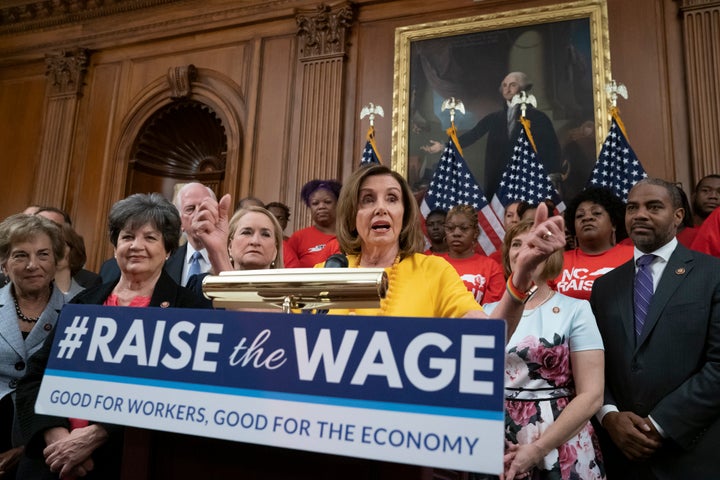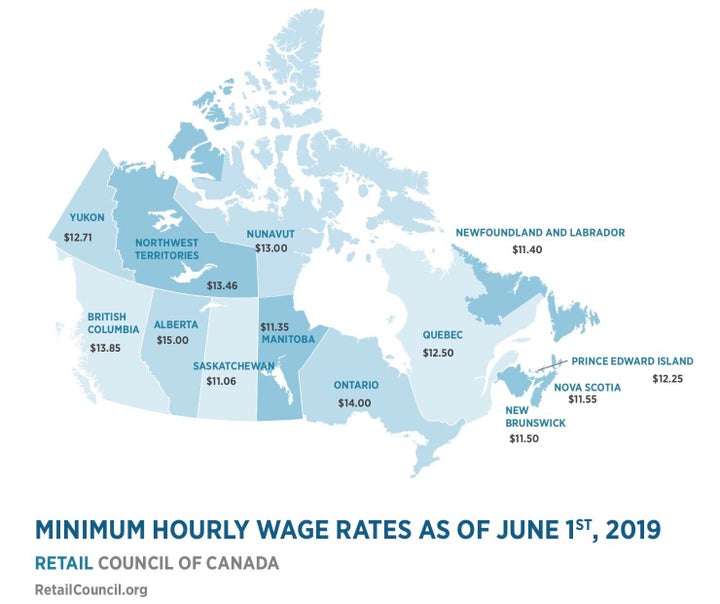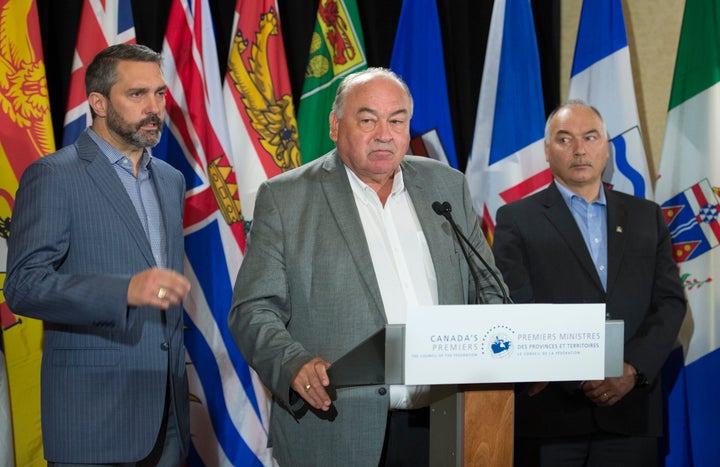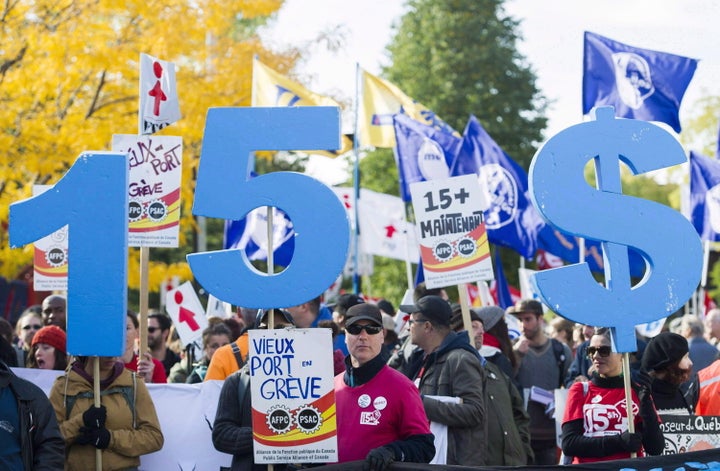
The United States is one step closer to a national $15 minimum wage.
The House of Representatives passed the Raise the Wage Act, which would effectively double the federal minimum wage from $7.25 to $15 by 2025.
While it is unlikely to receive support in the Republican-controlled Senate or final approval from President Donald Trump, the bill is still a big deal for labour rights activists. The minimum wage in the U.S. hasn’t changed since 2009. However, many cities have already raised their local minimum wages to $15 an hour on their own ― including Seattle, San Francisco and New York City. California, Massachusetts, New York, and the District of Columbia have all legislated a $15 on the state level.
The “Fight for $15” has become a rallying cry for advocates of a higher minimum wage south of the border. According to the Economic Policy Institute, a minimum wage increase to $15 would raise wages for 26.6 percent of the U.S. workforce.
Opponents worry that an increased minimum wage will lead to lost jobs. According to a Congressional Budget Office study published last week, the legislation would raise the wages of 27 million people, while leading 1.3 million fewer jobs in the United States.

Minimum wage continues to be a hot issue here in Canada — a new report from the Canadian Centre For Policy Alternatives (CCPA) found that minimum wage earners couldn’t afford a two-bedroom apartment in 97 per cent of Canada’s neighbourhoods. And as provinces incrementally increase minimum wage according to CPI, Canadian chapters of the Fight for 15 and Fairness campaign have sprung up on a provincial level for a $15 minimum wage.
According to Canadian economist David Green, raising the minimum wage could be a way to combat poverty here.
“A key way to tackle the problem of growing inequality is to raise the incomes of those at the very bottom of the income scale,” Green wrote in his 2015 report, “The Case for Increasing Minimum Wage.”
So, because we love to compare ourselves to the U.S., how are we doing?
Here are the provinces, from highest to lowest minimum wage.

$15 (or officially on the way there)
Alberta:
During the 2015 provincial election, Rachel Notley’s NDP ran on a platform that included raising the minimum wage to $15. While in government, they passed legislation and as of October 2018, Alberta has a $15 minimum wage. However, Jason Kenney’s United Conservative government passed legislation on June 26, 2019 to lower the provincial youth minimum wage for young workers to $13 per hour.
British Columbia:
The minimum wage in B.C. increased to $13.85 on June 1, 2019. John Horgan’s NDP government had campaigned on raising the wage to $15 by 2021, and if the planned yearly increases continue, B.C. will have a $15.20 minimum wage on June 1, 2021.
The living wage for a working couple with kids in Metro Vancouver is still calculated at $19.50 per hour according to the Living Wage for Families Campaign.
The rest (in descending order):
Ontario:
In 2018, Ontario’s now-former Liberal government bumped the minimum wage to $14 per hour, from $11.40. There were plans to increase the minimum wage to the full $15 at the start of 2019, however the increase was called off by newly elected Premier Doug Ford.
WATCH: Ontario marks a whirlwind year since Premier Doug Ford’s election. Story continues below.
Northwest Territories:
The minimum wage in the Northwest Territories currently sits at $13.85. Regulations in the territory do not mandate any sort of annual increases.
The isolation in Canada’s north continues to lead to a high cost of living. A 2019 report from Alternatives North stated workers in Yellowknife need to be paid almost $24 per hour in order to get by in the city.
Nunavut:
Prior to increases in the provinces and territories listed above, Nunavut had the highest minimum wage in Canada for almost a decade at $13. The minimum wage is reviewed annually in the territory on April 1.
The estimated living wage in Nunavut is $26 an hour.

Yukon:
A $12.71 minimum wage came into effect in the Yukon on April 1, 2019. The rate is tied to the Consumer Price Index and adjusted every year accordingly. The territory’s Employment Standards Board was asked by the government in 2018 to review the minimum wage.
The board recommended further increases in the next couple of years to bring the minimum wage above $15 by 2021, though there are no concrete policies for increases outside of those tied to the CPI in place yet.
Quebec:
Quebec’s minimum wage increased to $12.50 on May 1, 2019. With the increase, the minimum wage reached 50 per cent of the average hourly wage for the first time in provincial history, according to Quebec Labour Minister Jean Boulet.
The province’s ruling Coalition Avenir Québec campaigned on raising the minimum wage to $15, but has no specific timeline set.
“We will get to $15, but we are doing it in a progressive way,” Boulet told reporters in January.

Prince Edward Island:
The island province raised its minimum wage 70 cents to $12.25 on April 1, 2019. The province maintains the highest minimum wage of the Atlantic provinces, but according to Statistics Canada, average wages paid per week on P.E.I. are still the lowest in the country.
Nova Scotia:
Nova Scotia used to have the lowest minimum wage in Canada until the province increased it to $11.55 on April 1, 2019. There are plans for ta further 55 cent increase in each of the next two years, to $12.10 in April 2020 and $12.65 in April 2021.
Starting April 1, 2022, the rate will be adjusted annually according to the CPI.
New Brunswick:
Not far behind Nova Scotia, New Brunswick increased its minimum wage to $11.50 on April 1, 2019, to follow inflation as advocated by the CPI.
Newfoundland and Labrador:
The province also raised its minimum wage to $11.40 to follow inflation. There are no concrete plans in place for further increases.
“We will continue to monitor and review our labour standards legislation to ensure it remains relevant, responsive, and comparable to jurisdictions across the country,” Minister of Advanced Education, Skills and Labour Bernard Davis said when announcing the increase.
Manitoba:
Manitoba’s current minimum wage is $11.35, but it is set to rise to $11.65 on Oct. 1, 2019.
“We are providing predictable and sustainable increases to Manitoba’s minimum wage, which achieves the right balance benefiting both employees and employers,” said Manitoba’s Growth, Enterprise and Trade Minister Blaine Pedersen, in a release.
WATCH: What countries have tried universal basic income? Story continues below.
Saskatchewan:
The prairie province has the lowest minimum wage in Canada at $11.06 and will continue to even after an Oct. 1, 2019 increase brings it to $11.32.
In April, Don Morgan, Minister of Labour Relations and Workplace Safety, told Postmedia the provincial government is not currently considering upping Saskatchewan’s minimum wage beyond inflation-tied increases.
“We made the commitment when we amended our legislation to index our minimum wage so it’s predictable, it’s transparent. It’s the average between consumer price index and the average hourly wage, and that’s where we’re at and we think it’s a good place to be.”
BONUS: Why doesn’t Canada have a federal minimum wage?
Unlike in the United States, under our constitution the provinces and territories are individually responsible for setting and regulating labour laws. In 1996, the federal minimum wage was officially defined as the general adult minimum wage rate of the province or territory where the person did the work.